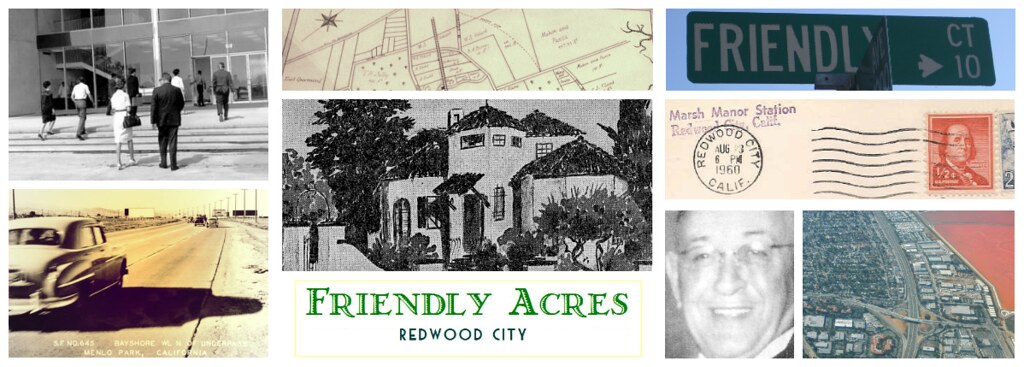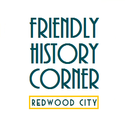The Friendly Castle
While visiting the San Mateo County Archives one weekend, I found a newspaper article on Friendly Acres. It appeared to be the only newspaper article that they had on file (at that time) for the neighborhood, or with any mention of Harry Friend.
The clipping, entitled "A Backward Look: Restoration at 'Friendly Castle'" - Archive Reference # 75-604.1 RC, is undated but it does include the name of the author, a Marian Goodman, who had been a Staff writer with the
Redwood City Tribune.
 |
| The big white Spanish-type "Friendly Castle" was built by Harry Friend, who subdivided and developed Friendly Acres in February 1934, selling lots for $20 down. |
The article introduces us to Ray and Pat Dufour, the then new owners of the "Friendly Castle" who had just moved in, (this is around 1966), and were redecorating the interior, and provides a retrospective of the previous owners and the significance of the house to the neighborhood.
"... This interesting house was built in 1934 by Harry Friend, who once owned all of Friendly Acres, as well as the Industrial Park area which he sold to David Bohannon. He also donated two acres of land for Taft school.
One neighbor recalls being offered $400 for the whole acreage, then a salt swamp. "Are you kidding?" she said, "I wouldn't have it for anything!"
For some time the Friendly Castle was the only house in the area, and it was outstanding because of its size, prominence, and unusual design. Friend knew just how he wanted it, and how he got it is quite a story.
In Russia, the last of the czars, Nicholas II, had a personal architect, a Russian Pole, named Kapliroff, who designed buildings for the emperor.
During the Russian revolution when the Czar and his family were murdered by the Bolsheviks, Kapliroff escaped, and was smuggled out of the country in a barrel.
He made his way to America, crossed the country, and happened to stop in Redwood City. He knew no English, but he met Harry Friend, who could speak Russian because he was born in Poland of Russian descent.
The two got along well, and when Kapliroff found that Friend wanted an architect to help with his new house, he was glad to oblige.
Otherwise, because of Kapliroff's language difficulty he didn't do well here. But someone suggested he go to Hollywood where they could use his type of designs. He did go to Hollywood and made a fortune before he died.
The Friends entertained a great deal in their showplace, and people came from all over Northern California to see it. Students came from Stanford to make sketches, and demands for the plans resulted in a few similar houses being built in Palo Alto.
But the Friends lived in the house only five years."
Goodman provides further descriptions of the interior of the house and renovations underway and ends the article by letting readers know Mrs Friend's current address. Already a widow by 1966, when this interview was given, Mrs. Friend was no longer living in Friendly Acres. The Friends had left the neighborhood in 1939 to settle in San Carlos, where Mr. Friend had a "smaller and less elaborate" house built for her, modeled on the larger one in Friendly Acres.
Apparently the reason for the move was that the house became too much for Mrs Friend to care for and she became ill. Its interesting to note that
Irene Winnick's oral history essay also indicates that Mrs Friend was ill but the reason they chose San Carlos was because it was "higher and drier" than "the salt swamp" and that they first moved to San Francisco for a while before settling down in San Carlos. (I presume they stayed in San Francisco either for medical care, or while they waited for their house in San Carlos to be built.)
The article provides other descriptions of the interior of the Friendly Castle and talks about subsequent owners who went on to occupy the place, including a Mr. Preston, a Gillette representative, and a Milton Engel - a chemist. (Editor's Note: Watch this space for an upcoming post on Milton's story which is decidedly colorful).
Special Note - Ms. Goodman, who wrote the article for the Redwood City Tribune, also wrote pieces on San Mateo history and, notably, would
accompany her submissions with hand illustrations of the topic she was
writing about. I came across 2 publications where she's also cited as
the illustrator - and clearly an accomplished one.
- Missions of California; Marian Goodman, Redwood City Tribune, 1962
- San Mateo County: Its Story; Marian Goodman, Goodman Publishing Co., 1967
Judging by the covers of these 2 books I suspect that the
illustration of the Friendly Castle which was in the Friendly Acres
article (see below) was most likely also done by Goodman.











